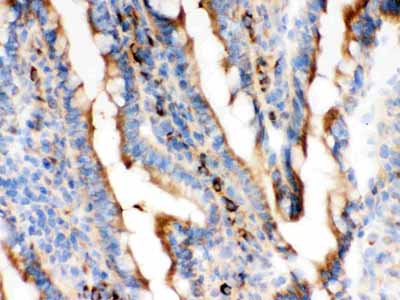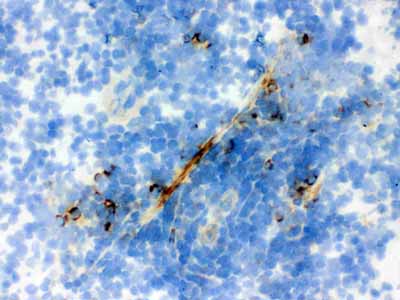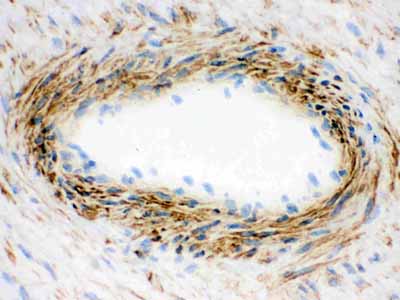Anti-Actin Antibody (Monoclonal, AC-40)
- SPECIFICATION
- CITATIONS
- PROTOCOLS
- BACKGROUND

Application
| WB, IHC-F |
|---|---|
| Primary Accession | P68133 |
| Host | Mouse |
| Isotype | Mouse IgG2a |
| Reactivity | Human, Mouse, Rat |
| Clonality | Monoclonal |
| Format | Lyophilized |
| Description | Mouse IgG monoclonal antibody for Actin detection. Tested with WB, IHC-F in Human;mouse;rat;chicken. No cross reactivity with other proteins. |
| Reconstitution | Add 1ml of PBS buffer will yield a concentration of 100ug/ml. |
| Gene ID | 58 |
|---|---|
| Other Names | Actin, alpha skeletal muscle, Alpha-actin-1, ACTA1, ACTA |
| Calculated MW | 42051 MW KDa |
| Application Details | Immunohistochemistry(Frozen Section), 4 µg/ml, Human, chicken, mouse, rat, - Western blot, 2 µg/ml, Human, chicken, mouse, rat |
| Subcellular Localization | Cytoplasm, cytoskeleton. |
| Protein Name | Actin, alpha skeletal muscle|Actin, alpha cardiac muscle 1|Actin, aortic smooth muscle|Actin, cytoplasmic 1|Actin, cytoplasmic 2|Actin, gamma-enteric smooth muscle |
| Contents | Mouse ascites fluid, 1.2% sodium acetate, 2mg BSA, with 0.01mg NaN3 as preservative. |
| Clone Names | AC-40 |
| Immunogen | Synthetic actin C-terminal peptideSer-Gly-Pro-Ser-Ile-Val-His-Arg-Lys-Cys-Phe,attached to a Multiple Antigen Peptide(MAP) backbone. |
| Purification | Ascites |
| Cross Reactivity | No cross reactivity with other proteins |
| Storage | At -20˚C for one year. After r˚Constitution, at 4˚C for one month. It˚Can also be aliquotted and stored frozen at -20˚C for a longer time.Avoid repeated freezing and thawing. |
| Name | ACTA1 |
|---|---|
| Synonyms | ACTA |
| Function | Actins are highly conserved proteins that are involved in various types of cell motility and are ubiquitously expressed in all eukaryotic cells. |
| Cellular Location | Cytoplasm, cytoskeleton. |

Thousands of laboratories across the world have published research that depended on the performance of antibodies from Abcepta to advance their research. Check out links to articles that cite our products in major peer-reviewed journals, organized by research category.
info@abcepta.com, and receive a free "I Love Antibodies" mug.
Provided below are standard protocols that you may find useful for product applications.
Background
Actin, a highly conserved protein, is a major component of both the cytoskeletal and contractile structures in the cell types. It varies in amount, being related to the type of differentiation and to the functional state of cells and tissues. The actins exhibit over 90% sequence homology, but each isoform has a unique NH2-terminal sequence. The isoforms are comprised of three alpha-actin, one beta-actin, two gamma-actin. Because the amino acid sequence of the C-terminal is the same for almost all actins, this antibody has been raised using a synthetic peptide corresponding to the C-terminal 11 residues.
If you have used an Abcepta product and would like to share how it has performed, please click on the "Submit Review" button and provide the requested information. Our staff will examine and post your review and contact you if needed.
If you have any additional inquiries please email technical services at tech@abcepta.com.













 Foundational characteristics of cancer include proliferation, angiogenesis, migration, evasion of apoptosis, and cellular immortality. Find key markers for these cellular processes and antibodies to detect them.
Foundational characteristics of cancer include proliferation, angiogenesis, migration, evasion of apoptosis, and cellular immortality. Find key markers for these cellular processes and antibodies to detect them. The SUMOplot™ Analysis Program predicts and scores sumoylation sites in your protein. SUMOylation is a post-translational modification involved in various cellular processes, such as nuclear-cytosolic transport, transcriptional regulation, apoptosis, protein stability, response to stress, and progression through the cell cycle.
The SUMOplot™ Analysis Program predicts and scores sumoylation sites in your protein. SUMOylation is a post-translational modification involved in various cellular processes, such as nuclear-cytosolic transport, transcriptional regulation, apoptosis, protein stability, response to stress, and progression through the cell cycle. The Autophagy Receptor Motif Plotter predicts and scores autophagy receptor binding sites in your protein. Identifying proteins connected to this pathway is critical to understanding the role of autophagy in physiological as well as pathological processes such as development, differentiation, neurodegenerative diseases, stress, infection, and cancer.
The Autophagy Receptor Motif Plotter predicts and scores autophagy receptor binding sites in your protein. Identifying proteins connected to this pathway is critical to understanding the role of autophagy in physiological as well as pathological processes such as development, differentiation, neurodegenerative diseases, stress, infection, and cancer.






